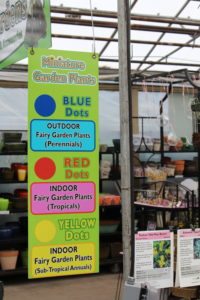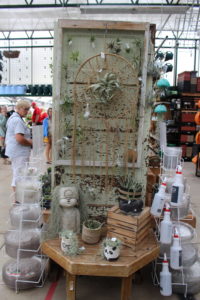Listening (And Responding) To You
Reader comments can help keep columnists and their ideas based in the real world, and occasionally, columnists can help retailers stay rooted in reality, too. This month, I’m taking the time to address some interesting reader comments and questions I’ve received recently. Thank you to each person who took the time to share his or her thoughts about my columns. Keep the responses coming!
Recapping ROI
Last month, this column focused on return on individuals (ROI) and discussed how to starve the losers and feed the winners. Many thanks to those who commented that this advice seemed “harsh, too capitalistic or insensitive.” Guilty as charged! Today’s garden center environment is certainly harsh. To call the marketplace insensitive is also accurate. The charge of “too capitalistic” is interesting. Like it or not, capitalism is becoming the universal system among all our neighboring countries. Pure capitalism can be defined as the allocation of resources where they get the greatest returns.
How is this relevant to getting a return on individuals? It’s that every business, every organization, every country, every person is looking for the best return on their “investments,” whether those investments are money, imagination, energy or time. Call it personal capitalism. It’s where we all want the highest reward possible for our risk or contribution, which brings us to that person who isn’t returning to the organization what it needs. In the last issue, we said employees needed to continue to learn new skills. We call this showing loyalty. They learn new skills so they can continue to be productive.
We learned of a garden center that quit offering mow-and-blow services (necessitating a crew to cut customers’ lawns and blow the clippings) 15 years ago. That customer list showed 250 homes or businesses, requiring them to have a full-time accounts receivable person. When they spun off the mow-and-blow business to the manager, the garden center kept the accounts receivable person, who now really has only about 90 minutes of essential work a day.
The rest of the time, she’s doing busy work or alienating the rest of the staff. Instead of learning new skills, she’s just doing whatever she needs to do to look busy and get by. Interesting that over the years she has become bitter toward her boss and co-workers. It will benefit both of you to “starve” such an employee.
To cut loose non-producing employees isn’t being insensitive. In fact, it’s being sensitive to the situation. Those employees don’t feel productive. They aren’t growing in their jobs. They deserve the opportunity to excel elsewhere. By taking action on this situation, you may be providing the catalyst necessary for them to boldly strike out in new directions.
Track Employee Results
To keep ROI foremost in your mind, track sales per employee both monthly and annually. What did you sell this month (year) against the number of full-time equivalent (FTE) employees? Because each garden center may be a bit unique, it’s not always practical to find a reasonable benchmark. You can track your results against your own history.
For most garden centers, tracking sales of individual salespeople isn’t meaningful because some employees will stay between the benches to work among the products and then send customers to a central cashier. You can, however, assign a daily goal for the entire team. Each day the team hits its goal, everyone who worked on the team that day gets a $1 bonus.
At the end of the month, you may see some team members received more money than others. If this continues, you may find that those with the most money were among your best producers. It’s the concept that winners bring the entire team along with them. Even if they didn’t write up the most dollars in tickets, if they worked on the big producing days, it’s possible they’re your catalyst for converting lookers into customers. These are the winners that should be “fed” and scheduled to work the busiest days.
Inquiring Reader Wants To Know
I recently received this question from a caller: “I’m going to the OFA Short Course. My wife says I shouldn’t buy at the trade show because I always buy too much and I buy the wrong stuff. What can I say to convince her I have to buy at shows to get the best deal in terms of price and delivery?”
It turned out this person’s wife questioned his judgment about buying at trade shows because she always looks at the merchandise left over at the end of season and real-izes much of it is either new varieties or merchandise the caller bought at shows. When winter comes and cash is tight, she also reminds him that if he hadn’t bought the new piece of equipment, they wouldn’t have a lease or loan payment due.
From a layman’s perspective, it looks like the two aren’t communicating about the needs of a retail garden center. Let’s look at the leftover merchandise issue first.
Consider this: Doctors bury their mistakes. Lawyers send their mistakes to jail. Poor retailers on the other hand leave their mistakes out on display for years where everyone can see them and the retailers can remind themselves what idiots they were for buying “bad” product. Smart retailers, on the other hand, do immediate markdowns as soon as it looks like a product was overbought.
The first markdown is the cheapest, so if you bought a new product and it has disappointing sales, it’s OK to mark it down midseason while you still have customers in the store. Waiting until the end of season to take your markdown reduces the chance of getting maximum cash for products that your customers have previously rejected.
Regarding the conflict over old inventory, was the wife accurate in assuming the trade-show-bought merchandise was more likely to be left at the end of the season? It’s possible her complaints were really a manifestation of her overall concern about cash tied up in dead inventory and not an accurate accusation of trade show purchases.
What About Buying Equipment?
Regarding the capital equipment issues, did the equipment purchase really cause the cash drain or is the accusation again covering a deeper concern? Does the company need better cash flow budgeting?
Two significant pieces of misinformation cropped up during this part of the conversation. First, the caller felt he had to “lease” his new forklift so he could expense the monthly payments. We sent him to his accountant. Most equipment leases for garden center equipment really don’t qualify as “operating leases” for tax purposes.
Whether you lease it, buy it outright or use a bank loan, many times the depreciation is treated the same. In this case, by trying to be clever in his tax planning, the garden center owner did himself a disservice by not bringing this lease to the accountant’s attention. It turns out the garden center may have been able to write off the entire lease this year under Section 179, which allows accelerated write-offs. The caller missed the opportunity because his accountant wasn’t told of the lease.
Second, depending on what you’re buying, some equipment suppliers will offer you “zero percent” financing or “free” financing. We’ve all probably heard of the Truth in Lending Act, also known as Regulation Z. We want to believe lenders can’t fraudulently misrepresent interest rates and there are proscribed ways to determine interest costs. In fact, Regulation Z covers financing for consumers, not for businesses. That’s why we find many business-to-business vendors who play fast and loose with the truth.
You may assume zero-percent financing means a piece of equipment you negotiate down to a $12,000 cash price and pay for in 24 months at $500 per month. That may or may not be the case. In most zero-interest situations, if you were to pay the vendor in cash, you would receive a discount of 5-20 percent. Clearly, a 20-percent discount for cash means there is no free interest. If you need a piece of equipment before you leave for the trade show, ask your bank what it can do for you and then offer the vendor cash. Most of the time, you’ll get a lower up-front price, which means the trade show “special price” is artificially high to cover the cost of financing. Remember: there is no free lunch.
Trade Show Solutions
We did offer a trade show solution for our anonymous caller. Just like going to the grocery store when you’re hungry, going to a trade show without a plan will cause you to overspend. Don’t buy anything you don’t have a plan to sell. If the vendor says you have to place an order at the show to get the special price, consider that a warning. Certainly, some vendors feel they need to give a show special to secure orders on site. Your job is to be sure any orders you place are likely to be successful for your operation.
One effective trade show tactic is to place an order to be shipped in one month. Then go back to your store. One week after the show, review all the orders and cancel those you aren’t still wildly excited about. If you’re still enthused about that new product, it’s a good sign. At that point, let the order stand.
Another practice successful retailers do is setting up an open-to-buy budget. Sure, you’re excited about a new variety. It’s beautiful, perfect for your zone and something your customers will love. Yes, they’ll buy it. But will the purchase of the new variety be additional business for you or will it be replacement business, meaning the customers will no longer buy an existing product? By having an open-to-buy budget, or a merchandise budget, you ensure you don’t buy more than your anticipated sales.
The point is that trade show buying, like every other part of your business, requires pre-planning, intelligent business planning and discipline.


















 Videos
Videos





